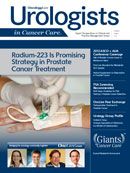Publication
Article
Oncology Live Urologists in Cancer Care®
Herbal Supplement Could Outperform Observation in Some Patients With Recurrent Prostate Cancer
Author(s):
A cocktail of herbs and vitamins lowered PSA in more than a third of patients with biochemically recurrent prostate cancer, and thus may be a good alternative to observation in this population.
Tanya B. Dorff, MD
A cocktail of herbs and vitamins lowered prostate-specific antigen (PSA) in more than a third of patients with biochemically recurrent prostate cancer (bcrPC), and thus may be a good alternative to observation in this population, according to study results published in conjunction with the 2013 Annual Meeting of the American Society of Clinical Oncology.
Since there is no standard for the treatment of bcrPC, and androgen deprivation therapy (ADT) has not been proven to prolong survival in these patients and may have “deleterious effects,” “a non-hormonal, non-toxic agent to reduce PSA would be a welcome alternative to observation,” wrote authors Tanya B. Dorff, MD, assistant professor of Medicine in the University of Southern California’s Keck School of Medicine, and colleagues. Their phase II study was not presented during the annual meeting, but was published in conjunction with the event.
The supplement used in the study was Prostate Health Cocktail, made by OncoNatural, which contains vitamins D and E, saw palmetto, lycopene, green tea, and soy extracts. The primary endpoint of the study was PSA decline.
To be eligible, men needed to have rising PSAs whose value doubled within 3 to 36 months and no evidence of metastases. Among the 40 men who participated, median age was 67 years and median baseline PSA was 2.8 ng/mL. Twenty-three percent of the men had Gleason scores between 8 and 10. Of the participants, 23% had been treated with primary radiation only, 25% with prostatectomy only, and 52% with both.
The men were given three PHC capsules daily for a median of eight 4-week cycles. PSA tests were done after cycle 1, and then every two cycles thereafter.
The investigators found that 37.5% (15) of participants experienced a decline in PSA of 55% or less, and of 35 men evaluable at 12 weeks, 9 men (25.7%) had PSA decline. The median “best” PSA change was 3.7% (range, -55% to 34.3%) and the median change in PSA at 12 weeks was 17.9% (-17.5% to 78.0%), Dorff said. Fortythree percent of study participants stopped therapy due to PSA progression, with a median time to progression of 10.2 months.
As of early July, 2 men were still in the study, 3 were continuing on the protocol after completing the trial, 3 had been lost to followup, 19 had developed metastases, and 13 were off study without having developed metastases
There was no significant change in testosterone or dihydrotestosterone during treatment, the authors reported.
Toxicities that may have been associated with PHC, none higher than grade 2, included transient liver enzyme elevations, gastrointestinal symptoms, weakness/dizziness/pain, and fatigue, the authors wrote.
“PHC is a potential alternative to observation in select patients with bcrPC,” the colleagues concluded.
In addition, the investigators suspect that PHC could be useful as an alternative to ADT. They plan to study PHC in comparison with placebo to determine not only whether the cocktail delays the time to metastasis, but whether it delays the need to start ADT, Dorff told Urologists in Cancer Care.
Nicholas J. Vogelzang, MD, head of the Genitourinary Cancer Program at the Nevada Cancer Institute, who referred patients for enrollment in the study, said it was easy to find eligible men interested in participating.
“We picked patients whose PSA was rising after radiation or surgery who were not ready to have their testosterone lowered,” he said. “Most men are attached to their testosterone—it’s part of their life—so many who have a rising PSA don’t want to have their testosterone lowered. That’s why an alternative to that, in the form of a pill or a vitamin, is very attractive.”
Dorff TB, Tsao-Wei DD, Howes D, et al. Final results from a trial of a combination herbal supplement for biochemically recurrent prostate cancer. J Clin Oncol. 2013; 31(suppl; abstr e1620).










